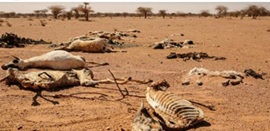Heavy rains cause deaths of drought-weakened livestock animals
Severe flooding has replaced the disastrous drought that killed millions of livestock in the Somali Region, further destabilizing an already fragile society.
The flood has claimed 45 lives, displaced 35,000 households, and killed 23,000 livestock in the Somali region alone, according to a report published by the United Nations Office for the Coordination of Humanitarian Affairs (UN OCHA) on May 12, 2023.

Over 300,000 people have been impacted by the devastating flash flooding that followed heavy rains that occurred in March 2023 in both Ethiopia and Somalia.
Abdifatah Mohamed Abdi, Deputy Head of the Disaster Risk Management Bureau, called the situation disastrous. He says the number of internally displaced persons (IDP) as a result of the flooding now reaches five million, much higher than what the OCHA reported.
“We were anticipating rain during the ‘Belgue,’ which is between mid-March to early April in the northern and southern parts,” he continued. “The drought devastated these places. Once the rain started, it was too intense to withstand.”
Kabridahar and Ogaden, in addition to other woredas in the region, have been heavily affected by flash flooding and water from riverbanks, according to him.
The flash flooding has also caused significant losses in livelihoods in drought-affected areas, including the deaths of livestock weakened by the drought and the degradation of fertile land. OCHA reported that 99,000 hectares of farmland have been destroyed because of the flooding.
“Many infrastructure facilities were devastated, rendering other regions inaccessible. Many are still trapped in flooded areas, and schools, clinics, and other institutions have been destroyed,” he said.
Reports indicate the prolonged rainfall that began in Kenya and went to the northern part of Ethiopia and Somalia’s highlands triggered the flash floods along the banks of the Shabelle and Juba Rivers.
The drought, according to Abdifatah, left a huge gap to fill, and the flood made society vulnerable.
“People need help with water and non-food items quickly,” he said.
The Ethiopian National Meteorological Agency announced that flash floods may occur in drought-affected areas in connection with the belg season rains.
In addition to the Somali region, Oromia, the South West, Afar, and the Southern Nations, Nationalities, and Peoples’ regional states have been affected by the recent flooding, which the UN OCHA called unusual.
Source: The Reporter


